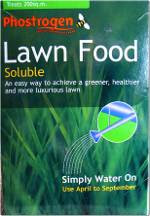If you followed the spring feeding recommendations, you should now have a lawn with some strong healthy roots, encouraged by the Phostrogen All Purpose Plant Food (N:P:K, 14:10:27).
At this time of year, cool season grasses virtually cease growing roots and concentrate on leaf growth. Consequently, it is a good idea to give a different feed (a high nitrogen one) which will support this.
Since there is still a high risk of prolonged dry weather (if only!), we need to be careful not to scorch the lawn by giving too much nitrogen feed (it is mostly nitrogen that does the scorching).
I find that liquid lawn feed is ideally suited to this situation, since it can be given in small accurate doses as and when required. Because it is rapid-acting, we can almost do this on a day-by-day basis if necessary. Liquid feed is far more flexible than granules in this respect.


Phostrogen Soluble Lawn Food (N:P:K, 38:5:5) is ideal. Not only is it easy to apply with a watering can or hose feeder, it also contains iron and so gives the lawn a beautiful rich dark green colour(at least I think it's beautiful) and helps keep the moss at bay (iron salts destroy moss).
I know it only lasts for 1 month (granular feeds last 6 to 8 weeks), but I have found it to be well worth the effort. And if in doubt, it can be given at half rate every 2 weeks (I said it was controllable). Furthermore, because it can enter the grass through both the leaf and the roots, the results can be seen almost immediately, rather than waiting 2 weeks for granules, which work only through the roots. It is also more independent of the weather.
Furthermore, because there are no nitrates in the feed (it is organic), we do not need to worry about it being leached down from the soil into the water supply. After attaching itself to the clay and humus in the soil, it should support enough growth to produce a tightly-knit luxurious turf. The only drawback is that this turf will still need cutting (Nothing's perfect, is it?). But I always think a lawn is improving when it needs cutting.
I am using this feed at half rate, for now, because of the dry soil. This will give me some growth and colouring but also some insurance against scorching if the weather turns hot and dry.
 If you are averse to cutting and think your turf is thick enough, but like the idea of rapid greenup, then I suggest you go for one of the new iron-rich granular feeds. These contain 2% iron sulphate to colour the grass, plus some feed to keep it ticking over and healthy. Although I have never used these feeds, I do not expect the greening effect to be long-lasting.
If you are averse to cutting and think your turf is thick enough, but like the idea of rapid greenup, then I suggest you go for one of the new iron-rich granular feeds. These contain 2% iron sulphate to colour the grass, plus some feed to keep it ticking over and healthy. Although I have never used these feeds, I do not expect the greening effect to be long-lasting.
No comments:
Post a Comment